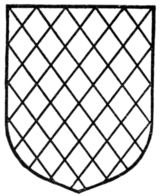The result produced is very similar to "lozengy" (Fig. 126), and care should be taken to distinguish the two.
Barry-bendy is sometimes blazoned "fusilly in bend," whilst paly-bendy is sometimes blazoned "fusilly in bend sinister," but the other terms are the more accurate and acceptable.
"Lozengy" is made by use of lines in bend crossed by lines in bend sinister (Fig. 126), and "fusilly" the same, only drawn at a more acute angle.
THE CHEVRON
Probably the ordinary of most frequent occurrence in British, as also in French armory, is the chevron (Fig. 127). It is comparatively rare in German heraldry. The term is derived from the French word chevron, meaning a rafter, and the heraldic chevron is the same shape as a gable rafter. In early examples of heraldic art the chevron will be found depicted reaching very nearly to the top of the shield, the angle contained within the chevron being necessarily more acute. The chevron then attained very much more nearly to its full area of one-third of the field than is now given to it. As the chevron became accompanied by charges, it was naturally drawn so that it would allow of these charges being more easily represented, and its height became






